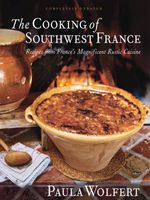To Cut Up a Duck
Published 1987
When you’ve mastered the cutting up of ducks, you’ll discover that they’re economically competitive with other meats. You’ll use the fat as a cooking medium or preservative; the neck bone, wings, and carcass will provide excellent stock for soups and sauces; the neck skin, if you’re skillful with a needle and string, can be stuffed (see Preserved Stuffed Duck Neck); you’ll be able to sauté, grill, or poach the breasts and braise, bake, or preserve the legs (see Traditional Confit of Duck). Miscellaneous bits and pieces also can be used in pâtés and rillettes (these two dishes, of course, are not fat-free). And even the carcass can be brushed with duck fat and roasted as described below. The liver can go into flans, stuffings, or salads. You can even sauté the heart as a special treat for yourself. (It takes four hearts to make one serving, so in France duck hearts are usually reserved for the cook—see Sautéed Duck Hearts with Green Grapes). You can preserve the gizzards in duck fat and use them in all sorts of bean-based or soup recipes, or in stocks and soups. And if you want to truly embrace the spirit of the French Southwest, you can even use the duck feathers to apply fat to pastry.
Photos
Become a Premium Member to access this page
Unlimited, ad-free access to hundreds of the world’s best cookbooks
Over 160,000 recipes with thousands more added every month
Recommended by leading chefs and food writers
Powerful search filters to match your tastes
Create collections and add reviews or private notes to any recipe
Swipe to browse each cookbook from cover-to-cover
Manage your subscription via the My Membership page
In this section
Part of
Advertisement
Advertisement


